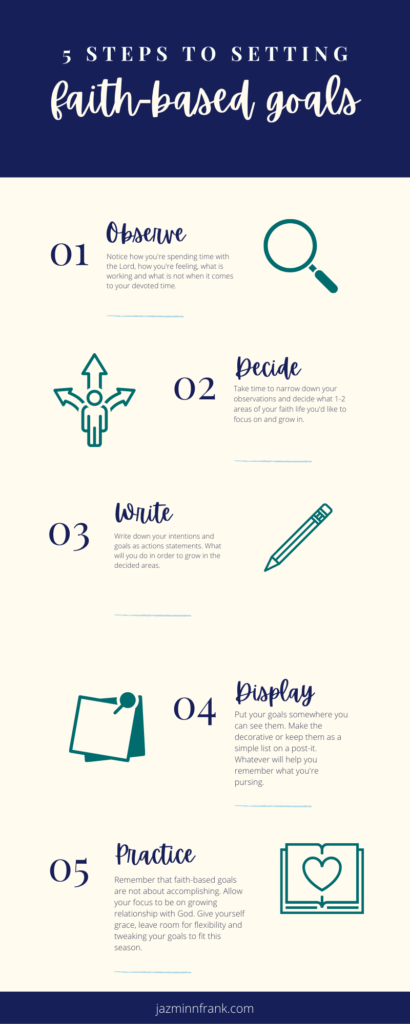**This post contains affiliate links. Read the full disclosure here.**
I’ve reached a weird spot in my faith life over the last year or so. I could blame covid, because the reality is that it has changed a lot of things. But I think it’s more true to say that the season I’m in has simply shifted.
The rhythms and routines I’ve been using to grow closer with God and read my Bible don’t work as well as they used to.
I need something different, something new.
So I’ve been doing some exploring.
I’m giving myself space to take a heart check, to notice what I need, what is giving me life and what is draining it.
I’m paying attention to the ways I feel close to God and the areas where I’m trying too hard.
I’m taking the time and making the space to set some new faith-based goals.
Why set faith-based goals?
We hear a lot about goal-setting in January. There’s something about a new year that makes us want to have a fresh start.
Maybe it’s the rhythm of the school year still hardwired in my system from years as a student and a teacher, but fall always makes me want to start fresh.
When we talk about goals, we often think about the outward stuff. We want to exercise more, eat better, be on time to things.
But how often do we take time to set goals and intentions for the internal things?
How often are we intentional with our faith life?
I ask this not to shame or put pressure. Lord knows that is the last thing we all need.
I bring up the idea of setting faith-based goals because maybe, like me, your faith life feels a little less than filling right now.
Because maybe you need something to help you feel and live a little more grounded, more focused, more joyful.
Setting faith-based goals can help you get a reset in your faith life and find new ways to connect with God in this season.

How to set faith-based goals
Step 1: Observe
The first step of setting faith-based goals–or any goals for that matter–is to simply observe your life.
How have you been spending your devoted time?
What rhythms or routines have you been doing and which ones have dropped off?
Where do you feel like your faith life is lacking? This is not an area you feel pressure to do more or meet some expectation. What do you feel is missing?
How have you and God been connecting lately? How is your relationship with Him as a whole?
What has God been inviting you to focus on?
When I observed my faith life and looked back at the areas where God has been speaking to me, I noticed a few things:
- Bible reading wasn’t fun for me, and I couldn’t read large chunks at a time
- I really wanted to get back to praying regularly and intentionally
- My weekly Sabbath practice had me bored and frustrated because I wasn’t sure how to spend my time
- I’ve been stressed out for a while and knew I needed more space for creativity and fun
Taking time to notice where you’re at and reflect on what’s working and what isn’t will help you begin to decide what areas of your faith life might need some attention in this season.
Step 2: Decide
After you’ve taken the time to observe, it’s time to make some decisions about where you will be putting your focus. This is not the same as setting your goals. We’ll get there soon.
I like to think of this step in terms of putting together a puzzle. When you observe, you dump out all of the puzzle pieces and begin sorting them out by type of piece–edges and inside pieces–or maybe by color.
Keeping with this analogy, deciding is where you pick one type of piece and begin working those into the puzzle.
This is the step where you determine what matters in this season.
Here are some questions to ask yourself as you decide:
What matters in this season?
What is one or two areas you want to grow in spiritually?
What is fun, creative, or helps you rest well?
What fills you up and how can you make more space for those things?
It is also good during this step to think about your whys.
If you decide to focus on an area of your faith life because you feel pressure or you feel like you should, you’re not going to do yourself any favors. Your devoted time will become a place of pressure and performance, which is something we steer away from around here.
Looking at my list of observations, I made a couple of decisions:
- I wanted to focus on Sabbath. I’d already been learning about the value of Sabbath and I wanted to find new ways to rest and enjoy each week.
- I approach a lot of my faith life through my head and I connect with God a lot through words. I wanted to explore–thanks to the idea from a friend–what it would look like to connect with God differently. Drawing on the 5 love languages, I decided to experiment what it might look like to connect with God through the language of physical touch.
Once you’ve made your decisions about your whats and your whys, it’s time to write out some goals and set some intentions.
Step 3: Write
When it comes to goals, especially faith-based goals, it’s always best to start small. There is absolutely no need to try and tackle everything at once.
The ultimate goal here is to grow, and it’s hard to do that when we’re bogged down by pressure and stressed by all the things we’re trying to accomplish.
Also, this is probably a good time to remind you that faith-based goals are not about accomplishing.
Faith-based goals are about connecting and growing closer to God.
They are about strengthening our faith muscles and investing in relationship.
The best way to set faith-based goals is to look at those areas you decided to focus on–don’t focus on more than one or two–and write a few intention statements.
When you write out your goals, write them as statements of action. What will you do and how will you do it?
I decided to focus on two main areas: Sabbath, and exploring what it would look like to connect with God through the love language of physical touch because I wanted to enjoy rest and find a new way to relate with God.
So I set these intentions:
- I will grow in my Sabbath practice by making space for activities I enjoy and view Sabbath as a day to play instead of a day to withdraw.
- I will explore ways to connect with God through physical touch through exercise, creativity, and food. I will let physical activity be a place of connecting with God in my body.
Step 4: Display
Once you’ve observed, decided, and written your goals, I find it helpful to display them somewhere.
My goals either get taped to the wall next to my calendar where I will see them clearly, or I keep the goal page of a Powersheets Goal Planner open and consult it daily to see how I’m doing with those goals.
The display doesn’t have to be complicated. A simple list written on a post-it note will do.
Stick them on a mirror or in a place you can regularly see them.
When you see your goals regularly you’re much more likely to follow through.
Displaying your goals helps you remember what matters to you in this season and to be intentional to pursue those things.
Step 5: Practice
And of course, the last step of setting goals is to actually practice them.
I chose the word practice because faith-based goals don’t usually involve a finish line.
These goals are about being formed.
And to let be formed, we have to be intentional to follow through.
If your faith-based goals involve routine, like reading your Bible every day, or doing a prayer walk once a week, stick those things on your calendar.
If your faith-based goal is more of a mindset, take a regular heart check or make time to reflect on how you’re doing with that goal.
If you miss a day, feel like you’re falling behind, or you’re struggling to make progress, give yourself grace. Tweak your goals if you need to. Give yourself space to experience those growing pains.
Allow the pursuit of these goals be a place where you commune with God.
Talk with Him about them, share your concerns.
Helpful resources for faith-based goal setting
If you’re looking for some additional guidance on how set goals that matter to you, I highly recommend the Powersheets Goal Planner.
This goal planner is one of the core tools I use in my devoted life. It provides space and guided prompts to help you determine what matters to you as well as space for goal tracking and regular reflection on your growth.
This is a great tool to use if you’re looking to make progress in your faith-based goals or other goals in your life.
Learn more about how to use Powersheets to set goals with God and how this tool helped me prioritize my heart.
Or grab yourself the latest set of the Powersheets Goal Planner.
Another tool I’ve found useful is the Next Right Thing book, journal, and podcast from Emily P. Freeman. I’m currently using the Next Right Thing Journal and love the space it’s giving me to notice different areas of my life.
In the Next Right Thing book and podcast, Emily does a great job of helping you make space for your soul to breathe and to take your next steps in love.
Whatever your next steps are in your faith, I pray that you’re drawn ever closer to God as you live devoted to Him.

Live in His love!



Thank you.
This is the best goal setting exercise for faith I’ve ever seen! Thank you. So helpful